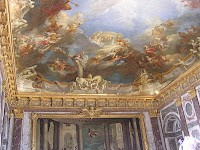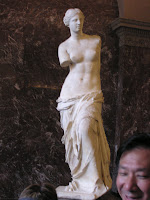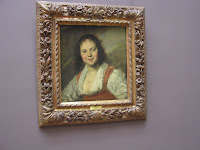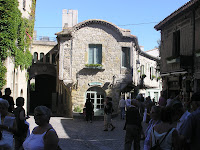
Seven hours on the rails transported us to Spain from Carcassonne. Part of the ride was on the famous high speed French TGV (Tran Grande Vitesse). A special treat for us in Spain was that Anne joined us for the week. The resort we had booked was in Beni Carlo, about 2 hours further south of Barcelona. Anne had to wait a day in Barcelona, as the train had no more tickets for this day. Barcelona is Spain’s 2nd largest city (pop 1.6 million). The capital, Madrid, is the largest city.
In Peniscola (spelling is correct), the resort hotel, Acusol, where we stayed had full kitchen facilities. Found a good grocery store and did much of our own meal preps.
I’m not sure what they sold in this particular store, but the name gave us a laugh. Groceries and wine were less expensive in Spain than in France and London. A bottle of wine could cost as little as 1 € (about$1.41 at that time).

Our location was within a short block of the Mediterranean. The weather was in the 80s, so we enjoyed swimming in Mare Nostrum (the Mediterranean Sea to the Romans). The water was warm and the beach was wonderful.

This part of Spain was controlled by the Moors (Arabs) for several centuries before being retaken by Christian armies. Each year, the locals stage a Moor-Christian celebration. By happenstance, the festival was held the week we were there. Featured in the very long parade are many different ornately-costumed citizens who represent either the Moors or the Christians.




An amateur hour type of bullfight was part of the entertainment. The bull was only taunted and no harm came to man nor beast. Instead of a red cape, the men waved coats and shirts of various colors. No glitzy costumes, just regular workday clothing. Having said this, it takes a sense of daring to step into the ring with these angry beasts.


Shortly after we left Spain, the Region of Catalonia, which includes Barcelona, outlawed bullfighting if the bull is killed. This was very surprising to me, as this practice has endured for centuries. The times they are a changing.
On a rocky outcrop sits the Knights Templar castle. It was constructed by the Knights between 1294 and 1307. The castle was the home of one of the schismatic Popes, Benedict XIII from 1415-1423. It is on this site that legend says that Hannibal took an oath to never be a friend of Rome, which he never was to his great loss. The castle has several shops and a church within its walls. The 1960 movie “El Cid” was partially filmed here. In the film it played the role of a castle in Valencia.



One large room is dedicated to the Knights Templar. These knights were officially endorsed by the Catholic Church in 1129. They became a very rich and powerful order. In 1307, the French king, needing more money (governments back then always needed more money – sound familiar?), trumped up some charges against the Knights and had them executed and surprise, kept their property. The Pope disbanded the order in 1312: after which the castle ownership changed hands to regional royalty.

On exhibit are some of the brutal instruments used to gain confessions of guilt. After your confession, the torture stopped and the priests heard your confession before your execution. Some days you just can't win. The rack pictured is really nasty. Besides stretching the victim’s body until shoulder and hip joints were dislocated, the rollers had sharp nails sticking out and as you were stretched, your flesh was also being ripped. Ouchy!! I wonder what sort of mind could think of such things, and what sort of person could actually use this on another human being. Well, we recently heard of water-boarding and beheadings. Different times and methods, same story.

Arising early one morning, we took the 7:40 bus to Vinaros (a small nearby town) in order to board the train to Valencia (Spain’s 3rd largest city, pop. 809,000, founded by the Romans in 138 B.C.). If you include suburbs, it is 2.3 million. Valencia’s heritage of ancient monuments, diverse scenic sites and cultural attractions makes Valencia one of the country's most popular tourist destinations. The crowded old city testifies to that.
I had misread the schedule and found that the early train was only on Saturday. We spent the next 2 hours walking around the industrial area of this small village. Anne did manage to get us senior discounts (over 60) for our tickets. Anne had taken a couple years of Spanish in High School, which came in very handy for us. Anne informed me that instead of telling the ticket person that I was 60 or over in years, that my mispronunciation of the Spanish word "annos" made it seem like I was saying something about 60 anuses. Live and learn.
The train station in Valencia is right in the heart of the old city, and is cavernous and ornate.

It is right next to the city’s very large bull fighting arena. Which, unlike Barcelona's, is still in use.

The tourist information center provided us with maps and much needed directions. They spoke English. Enjoyed the hustle and bustle of the main square while we enjoyed a lunch of Spanish specialties alfresco.
Valencia is a very old city and was once surrounded by high walls. The old city gate with its very thick wooden doors remains as a main portal into the old city. Where the old walls were, is now mainly parkland with many trees forming a green belt around the old city.

The architecture is ornate and interesting.

Naturally, there are many Catholic Churches in the old city. The Valencia Cathedral was one which we visited. Beautiful artwork abounds inside on the walls and altars.


The Museum of the History of Valencia was our next stop. It was a much further walk than we thought and when we arrived, they were closed for siesta (hot part of day). While walking to the museum, we discovered that there was a modern subway system in Valencia. A cold beer went down well while waiting for the museum to reopen.
The museum was one of the more unique museums that I have seen. The museum comprises about 50 exhibits, about 25% of them are audio-visual vignettes where actors re-enact specific places and times in Valencia’s history. You could select English as the language of the vignette. As there were few if any other patrons, English was the language of choice.
Valencia’s history goes from Roman, to Visigoth, to Moor, to the Spanish king. Flash photography is not allowed, so most of my photos did not work out. However, did get a photo of a Visigoth funerary artifact

and some Moor plates.

The city’s appearance changed when Moors overran the area in the 9th century. The Moors planted orchards and many gardens. They used methods of drip irrigation that used water to its best in this very dry land (Spain is not quite a dessert, but almost). In the 1230’s the King of Aragon (now a part of Spain) wrested control of this area from the Moors. It was only in 1609 that Spain expelled the last of the Moors from the kingdom. Valencia became one of Europe’s primary trading cities by 1499, especially in silk goods from China.
The subway brought us back to the train station to catch the 8 PM train to Vinaros and then the bus back to our hotel. A great day. The museum was the highlight of our time in Valencia. There is much more to see and do in Valencia (& everywhere else we roamed), but you have to select the few that you can experience in the limited time that you have.
The following day, we took an organized bus tour to the walled-city of Morella, high in the mountains about 50 miles from our hotel. This was the only guided tour that we took during our time in Europe, as we like exploring at our own pace. Having said that, this seemed interesting and we knew we would not be able to get there on our own – thus the tour.
Met Americans from our hotel also on the tour. The bus made several stops picking up other tour members. The guide was fluent in English and several other languages and gave his nonstop narration in Spanish, English, German and French. The area we traveled though had many orange groves (growing Valencia oranges, what else?), olive and almond groves were plentiful, and fields of aloe. All appear to be drip irrigated to save precious water.
Our first stop was at the very old Church of the Mother of God at Villanaus. This is a very old church, with the usual ornate altar and other artwork. There were many artwork tiles within. Tiles are very prevalent forms of art in both Spain and Portugal.



Back on the bus for the steep and winding road that leads to Morella. The terrain changes from orchards to grazing for sheep and goats. The pastures all appear very brown, dry and rocky. Our guide tells us that the population in this area has dropped from about 10,000 to 3,000 as opportunities in the cities have drawn away the young over the past 3 generations.


In the distance, we can see Morella on a hilltop.

The area was first settled by ancient Iberians, then Greeks, followed by Carthaginians, Romans, Visigoths and Moors. The Romans built the castle to protect the trade routes through the mountains. I surmise that there must have only been one route through the mountains to justify a castle in such a remote location. As the Romans were known to do, they constructed a very large aqueduct to bring water from even higher mountains to the city.

We enter through the gates of the walled city

and our guide begins a seemingly endless narration about the city and where to shop and where to eat, etc., etc. As he drones on, I am checking out the eateries that we pass, as most display their menus and prices. His recommended restaurant is, not surprisingly, the most expensive of the dozens of restaurants we pass. We decide to pass on any more of his narration and explore the city and the castle on our own, as our time was quite limited. That is one of the things I do not like about organized tours, you are on their schedule. Our focus is rarely shopping or eating, and more of let’s see what this place is and was about.
Found a sidewalk café and enjoyed Spanish foods (4 types of sausage, salmon in sauce, chicken and fish in a white sauce plus veggies and potatoes). Here is an example of some of the delicious honey, walnut and almond pastry that we gorged upon. You can drool, I sure did and am just looking at this concoction.

After lunch, we begin an upward climb through the narrow streets that lead to the looming castle.


The castle district is surrounded by a thick and tall wall. I cannot imagine how any army could have conquered the city (other than by a long siege), but it did change hands several times up to and including the Spanish Civil War of the 1930’s.

On the way up we enter the old Church of Maria la Mayor, a Franciscan church and convent complex. Much of it is in process of being restored.

Panoramic views of the surrounding countryside and of the city itself give us a visual banquet.


Huff, puff, we make it to the top level of the castle and savor the moment.

The tour bus schedule says we must leave, so we hustle down and do a bit of shopping on the way back. Unfortunately, the shop that Elaine wanted to visit was closed for siesta.
On the way back, we stopped at a ceramics shop and a local winery. The pottery shop gives a demonstration on how to make pottery. However, much of the tourist pottery is now made in China. So this may be the last generation that makes pottery from local clays that have been producing from time immemorial. The chances of us getting any pottery home without breaking it are low, so we pass on purchasing.
The winery is owned and run by a young (in their 30s) couple. They have some very nice wine and we buy a couple of bottles. One of which we brought back to the USA and have since consumed. The husband is also a skilled cooper and makes oak barrels for his use and for sale.
The guide enlightens us about the olive trees of this area, some are 1,000 years old. Spain produces about half of Europe’s olive oil. However, many of the trees will soon be cut down, as the EU has ruled that Spain must cut its production for some reason that remains unknown.
The following day, we say farewell to Anne as she boarded the train to Barcelona, where she would stay overnight. Anne reported that Barcelona was a fun city, “viva la fiesta, viva la noches.” It was so much fun to share the week with Anne.
The day after Anne left, we left. However, we went in the opposite direction. Our train left at 7:30 AM for Valencia, so it was an early get up for us (up at 5:45). Had a 3 hour wait in Valencia before our noon train to Seville was scheduled to depart. Enjoyed a light lunch and some people watching in the interim.
The train to Seville was quite luxurious; it even had movies broadcast to several screens in each car. Unfortunately, they could not seem to show a complete movie. First “The Gladiator” and then “Alice in Wonderland” were partially shown and then without warning they would be started over in a different language … none ever came close to the end of the movie. The trip from Valencia to Seville (Sevilla in Spanish) was 7 hours long and it was an express train (limited # of stops). The scenery changed as we went along from small orange and almond groves to high plains with large crop fields, then to vineyards. Then we were in high mountains, where we saw the first cattle since leaving France. As we descended to Seville, large cotton fields and olive groves were dominant.
Seville is the 4th largest city of Spain (pop 700,000, if you include the metro area it is 1.5 million). It is almost dark when we arrive. Fortunately, I had booked a room within a 10-minute walk from the train station. Unfortunately, the hotel was very difficult to locate, as it had only a very small and inconspicuous sign above the doorway. After wandering around for a while, we did find the hotel. Our room was small, but it did include a toilet/shower. Explored the neighborhood and found a restaurant for supper. It seems that they do not sleep in Seville, as at 10 PM the streets were full of people to include even very young children. The noise of people went through to at least 3 AM. Maybe that was because it was Friday night.
The city itself is said to have been founded by Hercules (in reality, probably by the ancient Phoenicians). Seville is an inland city on the banks of the river Guadalquivir. Its history follows much of the rest of Spain, going then to Rome, Vandals, Visigoths, Moors, Castilians, etc. Evidence of the Roman period was just outside of our hotel, where the remains of the Roman aqueduct serves as a reminder of those long-ago colonizers.

Our travels took us to Seville, because Seville is the quickest way to get to southern Portugal from Spain. No railroad links Spain with southern Portugal, so one must take a 2-hour bus trip from Seville or a 14-hour rail trip through Lisbon. I later determine that it probably would have been less expensive and time consuming to fly from Valencia to the Algarve region of Portugal (our next destination).
Had the better part of a day to tour before our bus departed. Found the appropriate bus to get us from our hotel to the bus station (other side of city) where we put our luggage in a locker and tour unencumbered. Our main stop was the Cathedral of Seville, where we spent our day.
The Cathedral of Seville is also known as the Cathedral of St. Mary. It was built from 1401 to 1519. The exterior shows a clear influence of a blend of Moorish and Christian architecture. It is the largest of the Gothic Cathedrals of Spain. One of the bell towers was first a minaret (see picture) dating from the 1100s.



The interior featured very high ceilings supported by massive pillars,

a beautiful pipe organ,

and hundreds of golden objects. The gold came from Spanish conquest of the Incas and Aztecs. There was even a large altar made from solid silver. The wealth contained in Europe’s churches and museums is truly astounding.

The reason why I wanted to see this cathedral is that the tomb of Christopher Columbus resides in this cathedral.

Columbus’ body did almost as much traveling after he died as when he lived. As you know, Columbus sailed to the New World 4 times between 1492 and 1504. He died in 1506 and was buried in Valladolid, later his remains were removed to Cartuja monastery in Seville. In 1542, his body was removed to Santo Domingo in today’s Dominican Republic, as it was felt that his body belonged in the New World. In 1795, the French gained possession of the entire island of Hispaniola (today includes Dominican Republic and Haiti). The Spanish then moved his bones to Havana, Cuba, where they remained until 1899. Upon losing Cuba in the Spanish-American War in 1898, Spain placed his remains in the Cathedral of Seville, where they remain to this day. A controversy began in 1877, when it was asserted that his bones still remained in Santo Domingo. This controversy was laid to rest in 2003 when DNA samples of the Seville remains indicated that these were Columbus’ bones. Those remains in Santo Domingo have never been DNA tested and are entombed in Santo Domingo’s Columbus Lighthouse.
After leaving the cathedral, we find a sidewalk café and order tapas. They spoke very little English and we know very little Spanish. Ordered cold beer (cerveza) successfully. However, the food part wasn’t so successful We were quite sure that we ordered a meal of some sort of pork. Apparently everything on the menu was pork, because when we attempted to ask the waiter what several of the items were, he said, “it is a type of pork” to everything we asked. Two very small plates of some sort of pork arrives. Fortunately, the beer is cold as it is in the high 80s. Thought that this was going to cost a lot for very little food, but ended up paying almost nothing for the pork. Apparently he brought us small appetizers and not the meal. Oh well, that’s the fun of travel in a non-English speaking land, you never know what will happen. Did not have time to wait for more food, so got ourselves to the bus station and boarded our 3 PM bus to our next destination …. Portugal. The bus seems to be full of Americans. One family is on a 4-year round the world experience. They had no itinerary where they would be and were just traveling with their 2 elementary school-age children (will be home schooled as they travel).
Thus ended our time in Spain.



















































































































































